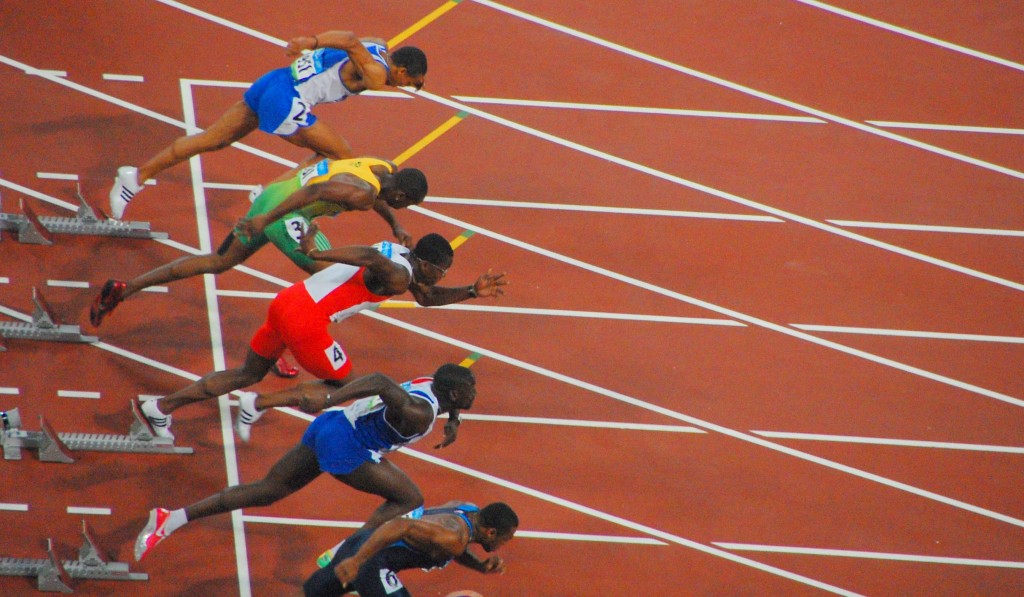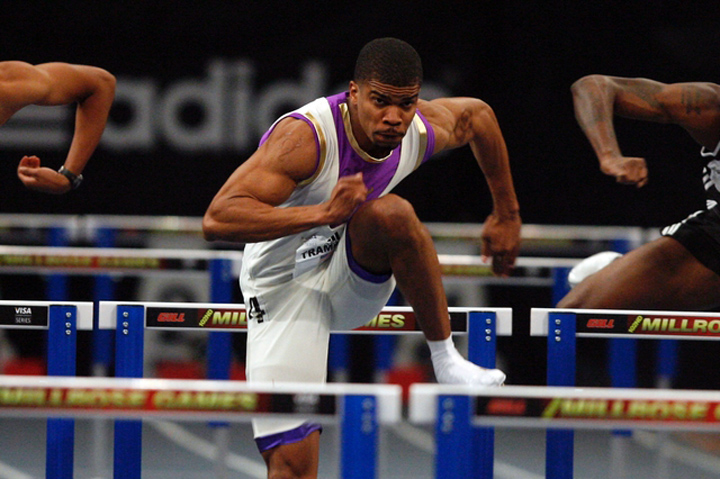Upper Body Posture
When it comes to maintaining forward momentum throughout a hurdle race, whether you’re talking about the short hurdles, the long hurdles, or even the steeplechase, upper body posture is very important. Hurdlers who run too erect or who even lean back a little are setting themselves up to work much harder than other hurdlers, which can create flaws in hurdling mechanics that lead to late-race breakdowns.
Good posture (running “tall”) basically means running on the balls of the feet, with the ankles dorsi-flexed, with the hips over the feet, with the chest pushed forward.
In the short hurdles, the problems often start with the start. If you pop up out of the blocks instead of driving forward, you’ll be too erect at the first hurdle. And though you may clear the first hurdle before any of your opponents, you won’t be able to accelerate through the hurdle the way you should. So by hurdle three, the advantage you gained will be lost. By hurdle five, you’ll feel the pack passing you by as you struggle to keep up. The problem is, because you popped up out of the blocks, you reached top speed too soon, which means you will begin to decelerate too early. And when you decelerate too early, you get walked down.
[am4show not_have=”g5;”]
[/am4show][am4guest]
[/am4guest][am4show have=”g5;”]
Another issue caused by popping up out of blocks too soon is that it causes you to clear the first hurdle too high. With one hurdler I coach, I’ve pointed out to her that when she drives out of the blocks, she clears the first hurdle nice and low. But when she pops up, she is way too high over the first hurdle. And when she’s way too high over the first hurdle, she ends up being too high over all the hurdles. The first hurdle sets the tone for the whole race. What you do on that very first step out of the blocks can usually indicate how the entire race will go.
When you practice your start, be aware of your body positioning. A hurdler doesn’t want to drive like a sprinter, but a hurdler does want to drive. Even as you get your eyes on the crossbar, you still want to be driving through the first hurdle.
 In this photo from a 2008 Olympic semi-final heat, you can see the importance of driving forward out of the blocks. Even those who have their eyes up (Robles in lane four, Doucoure in 5) are still driving.
In this photo from a 2008 Olympic semi-final heat, you can see the importance of driving forward out of the blocks. Even those who have their eyes up (Robles in lane four, Doucoure in 5) are still driving.
Hurdlers who pop out of the blocks tend to run the whole race too erect. Their lower body is always fighting their upper body. The lower body is trying to push forward while the upper body is pulling back. This push and pull is what causes flaws in hurdling mechanics. Too often, we notice the flaws in hurdling mechanics and try to address them, when the truth is that the flaws in hurdling mechanics are a consequence of erect posture.
The most common flaw caused by erect posture is that the foot of the lead leg kicks out too soon, inhibiting proper knee drive. When the chest is not pushing forward, when the hips are not pushing forward, then it is impossible to execute proper knee drive into the hurdle. Even if you don’t swing from the hip, you’ll have to kick the foot out too soon just so you can get over the hurdle. So, instead of trying to fix the problem by focusing on the hurdling flaw, it would make more sense to correct the body angles. If you’re not in proper position to clear the hurdle properly, then no amount of work on fixing the lead leg will be successful.
The next flaw is that the arms twist. It’s a domino effect. The erect posture causes the foot to kick out too soon. The kicking out of the foot creates an imbalance. To correct this imbalance, the arms instinctively swing across the body.
Besides popping up at the start, there are two other moments when erect posture can creep in to a hurdler’s running mechanics. The last step (or steps for long hurdlers) into the hurdle, and during descent coming off the hurdle. The “Last Step Stomp” article of last month’s issue explains this first problem. The hurdler driving forward nicely and then right before the hurdle he or she rocks back and stomps that last step, negating all forward momentum that had been built up in the previous strides. Hurdlers who also long jump, triple jump, and/or high jump are prone to this problem, as, in those events, they want to have some elevation.
 In this photo, Sally Pearson (left) demonstrates exquisite hurdling technique, while Kellie Wells (right) demonstrates the forward angle that hurdlers want during take-off. Notice that knee of Wells’ lead leg is already above the bar before she has left the ground, and that she is taking off from the ball of her foot, with her hips driving forward.
In this photo, Sally Pearson (left) demonstrates exquisite hurdling technique, while Kellie Wells (right) demonstrates the forward angle that hurdlers want during take-off. Notice that knee of Wells’ lead leg is already above the bar before she has left the ground, and that she is taking off from the ball of her foot, with her hips driving forward.
As for coming off the hurdle, I always point to Terrence Trammell as a hurdler who does an excellent job of holding his lean as he descends, thus increasing his forward momentum off of each hurdle. A lot of hurdlers will “stand up” as they drive their lead leg back to the ground. Again, this habit negates the speed and momentum that had been gathered up to that point. Hurdlers who stand up off of hurdles are constantly engaged in a rhythm struggle. After standing up off the hurdle, they have to re-position their upper body for the next two strides, keep it through the hurdle clearance, then get it back again after standing up off the hurdle.
 Check out the forward momentum Trammell maintains upon descent off the hurdle.
Check out the forward momentum Trammell maintains upon descent off the hurdle.
For the long hurdler, the erect posture in the last steps before the hurdle is caused by indecision. Trying to figure out whether to keep driving forward or to shorten the strides. Should I go for it or play it safe? While trying to figure this out, by all means, maintain your angles. Keep your hands high, keep your chest pushing forward, stay on the balls of your feet. That way, even if you stutter, your momentum will still be going forward, into the hurdle. If you sit back, or rock back, you’ll be running on your heels, and the stuttering will destroy your momentum.
Long hurdlers also tend to reach with the foreleg when fatigue sets in, trying too hard to maintain a certain stride pattern. This reach with the foreleg causes the foot-strikes to land in front of the hips, creating that push-and-pull posture that I mentioned earlier. Again, maintain your angles.
That’s why I emphasize, over and over again, that when you do your warm-up drills – you’re A-skips, your B-skips, your high-knees – be aware of your angles. Be aware of your upper body positioning. Be aware of how the drills directly relate to how you want to run.
[/am4show]
